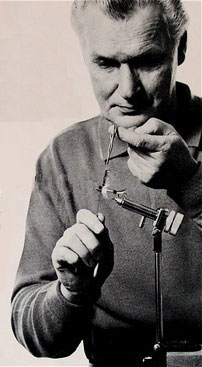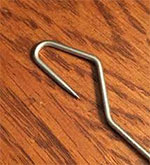Notes:  The Bird's Nest is a nymph pattern designed by the late Calvert "Cal" Bird in 1980. Cal was a master fly
tier, who owned a small fly shop in San Francisco in the 40's and 50's. According to Chuck Stranahan: "Cal and Helen were frequent visitors when I had a shop near Burney, California, during the late '70's and early '80's. We fished Hat Creek and the Fall River, where our experiments with fly design took shape under the acid test of those two exceedingly demanding and difficult waters. Late in the 1980 season I got a phone call from Cal: "Chuck, I've come up with a new fly. It's simpler than a Hare's Ear, more versatile than a Muddler Minnow, and it's a wonder nobody has come up with it before." He went on to describe his success with the new pattern on Arcularius Ranch on the Owens River the weekend before, where he caught an eight pound brown on this new fly he called the Bird's Nest." The Bird's Nest is a nymph pattern designed by the late Calvert "Cal" Bird in 1980. Cal was a master fly
tier, who owned a small fly shop in San Francisco in the 40's and 50's. According to Chuck Stranahan: "Cal and Helen were frequent visitors when I had a shop near Burney, California, during the late '70's and early '80's. We fished Hat Creek and the Fall River, where our experiments with fly design took shape under the acid test of those two exceedingly demanding and difficult waters. Late in the 1980 season I got a phone call from Cal: "Chuck, I've come up with a new fly. It's simpler than a Hare's Ear, more versatile than a Muddler Minnow, and it's a wonder nobody has come up with it before." He went on to describe his success with the new pattern on Arcularius Ranch on the Owens River the weekend before, where he caught an eight pound brown on this new fly he called the Bird's Nest."
Usually tied in tan colors to imitate caddis pupae,
other colors used are cream, brown, and olive. Cal actually used a blend of Australian Opossum and dyed Coyote for the dubbed body. He
also insisted on Woodduck flank for the tail and hackle to achieve the proper stiffness. Often, other flytiers will substitute Teal or Mallard Flank and utilize Haretron or a similar dubbing for the body. The use of dubbing blends was important to Cal as no natural insect will have a single color. Cal liked to use a blend of 50% Gray Australian Possum, 40% Hare's Mask (as a substitute for Coyote), and 10% Simi Seal (as a substitute for Seal's fur) in a spectral coloration. According to Ralph Cutter in his fine
book, "Fish Food" (2005), Cal claimed that he gave the fly it's distinctive name due to an entanglement
with a bird's nest while on the Truckee and that the name should be spelled with a lowercase 'b'. Their mutual friend, Polly
Rosborough, hinted that it may have gained a different spelling after he chided Cal upon naming a fly after himself. You might notice that the pattern also uses Polly Rosborough's technique of "tying in the round", which was particularly popular during the 1950's. Another interesting feature is the rougher thorax with more protruding fibers.  Frank Matarelli, a neighbor of Cal, designed a hook, known as Cal Bird's Dubbing Tool, This tool is used within the "improved" Bird's Nest to create a dubbing loop in which the Opossum dubbing is applied for a more buggy look on the thorax. Frank Matarelli, a neighbor of Cal, designed a hook, known as Cal Bird's Dubbing Tool, This tool is used within the "improved" Bird's Nest to create a dubbing loop in which the Opossum dubbing is applied for a more buggy look on the thorax.
The Bird's Nest is generally considered an attractor pattern that can be fished on a dead drift, either weighted or unweighted. Sierra guide, Ralph Cutter, prefers to use this pattern for hatches of the Swimming Nymphs, Siphlonuridae, which include the Gray Drakes, Black Drakes, and Ameletus. He will use short strips which gives the Bird's Nest a lively action with the hairs of the body pulsating to the action of the Woodduck hackle. Application of dessicant powder works well with this pattern as the powder will help to trap air bubbles within the hackle overbody. This produces a shimmering effect that is often seen within natural pupa rising to the surface. The Bird's Nest is often tied with beads of copper, gold, or black.
Variations on the
Bird's Nest include Ken Morrish's Dirty Bird. Ken's fly is usually tied in Rust, Olive, and Natural Hare's Ear. It is a popular Steelhead fly in larger sizes of 6 and 8 but can be a good trout fly in the smaller sizes. The unique twist on this pattern is the underwing of flash and utilizing Partridge rather than Dyed Mallard for the wing and tail. The abdomen is longer while the thorax is also substantially smaller. The pattern tends to be more of a caddis pupa imitiation and the Partridge hackle provides a soft hackle effect. Greg Vinci added an additional Tungsten bead and a tungsten wire underbody (Tungsten wire is popular in Europe but very dificult to find in the U.S.). He call's his variation, Depth Charge Bird's Nest. Tied in sizes #14-16, the Depth Charge represents Caddis Pupae. In slightly larger sizes #10-14, the pattern is more of an attractor pattern. Greg will also tie this pattern in sizes # 6-10 using Ginger or Golden Stone Goose Biots for the tails and antennae to represent a stonefly nymph pattern. Sierra Drifter Guide, Tom Loe, came up with his version that he ties in a light and dark variation. He named this variation, Assassin. The abdomen is Hare's Ear that is elongated almost to the bead with a short thorax about the same width as the bead with the same Hare's Ear. |


